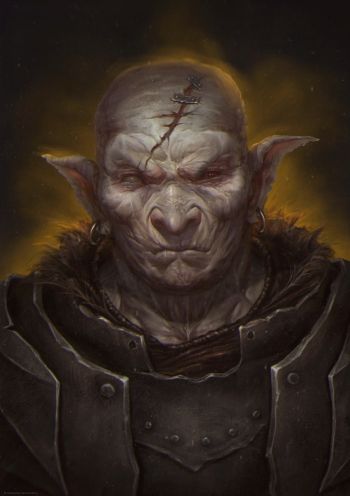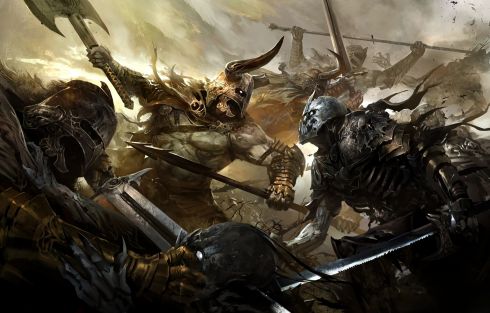Difference between revisions of "Hobgoblin"
Tao alexis (talk | contribs) |
Tao alexis (talk | contribs) |
||
| Line 30: | Line 30: | ||
== Behaviour == | == Behaviour == | ||
| + | |||
| + | [[File:Hobgoblin.2.jpg|right|490px]] | ||
WORKING... | WORKING... | ||
Revision as of 21:37, 13 September 2020
| Species | humanoid (goblinish) |
| No. Appearing | 3–30 |
| Behaviour | clan |
| Range | alpine, barrens, taiga, tundra |
| Size | 6 ft. 6 in. tall |
| Weight | 225 lbs. |
| Intelligence | 10–11 |
| Armour Class | 5 |
| Hit Dice | 1+1 |
| Action Points | 5 |
| Max. Stride | {{{stride}}} |
| THAC0 | 20 |
| Hp/Die | d8 |
| Attack Forms | claw or by weapon type |
| Damage | 1–8, varies |
| Special Attacks | infravision, tribal standard |
Hobgoblins are tall, slender humanoid creatures with stiff, leathery hides sparsely covered with thin, black hair, with facial characteristics and attributes that suggest an Oriental appearance. It is almost certain that their original appearance has been altered by the presence of human Asian heritage in their background, as these creatures mated with the Tunguskic peoples who were completely supplanted thousands of years ago. Hobgoblins are intelligent and exceptionally heirarchical; they are the masters of a vast area of north central Asia known as the Vostoch Empire.
History
According to the Baykal Stele, the 73 ft. monument erected east of Vosba-Limma on the shores of Lake Baykal, a group of Fifty Tribes emerged from the Kodar Gate in a single migration, travelling southeastward until reaching the land where the Ankara River leaves Lake Baykal. Though numbering only 7,500, throughout the Paleolithic period they spread to occupy lowlands throughout the Yenisey, Ankara and Lena valleys. Conflicts between them and the dwarves of Altslok reach far back before written or even oral history. Hobgoblins fought aggressively with other migrants from Kodar: with norkers and xvarts in the east; and with orcs, haruchai and ogres in the south. They reached a truce with the bugbears who settled in Nissi An, to the north, and with the gnolls of Samoyadia. They enslaved goblins (who would later escape far to the west to the lands of Magloshkagok) and set out to eradicate kobald tribes that tried to settle in their lands.
Surviving Tunguskic humans were driven south and east, forming the Jurchen people, who would later become the Jin and thereafter the Manchus. It has long been suspected that the Manchus benefitted from hobgoblin ancestors, but the accusation, even through the use of divination, remains suspect. While hobgoblins are intensely disliked by their neighbours, they are also respected for their military prowess, organization and efficiency in times of war; as a race, they possess a war machine that surpasses its rivals, except the dwarves, who remain the hobgoblin's most hated enemy.
Biology
Hobgoblins are able to produce healthy offspring through incestral practices, so that the practice of marrying siblings or near cousins is institutionalized. Children are raised and trained by every member of the tribe, ensuring a hive-minded ideal with regards to obedience and philosophy. Hobgoblins carry the eggs of their young up until a week before they are hatched, at which time a single egg is brought forth. Hobgoblins require 6-7 years to mature as combatants and are able to mate one year later. The hobgoblin's lifespan is about 35 years. They possess infravision and make good use of their olfactory senses as well as their sight. They are well-suited to the extremely cold climate of their homeland, which produces some of the coldest weather anywhere on Earth.
Behaviour
WORKING...
See Bestiary
Tribal bands of hobgoblins are likely to be encountered nearly anywhere. Each tribe is jealous of its status, and if two tribal bands of hobgoblins meet there will be at least catcalls and derision (85%) and open fighting might break out (15%) unless a strong leader such as a powerful monster or fighter or evil high priest, etc. is on hand to control them.
For every 20 hobgoblins in a group there is a leader (sergeant) and 2 assistants. These hobgoblins will have 9 hit paints each. If 100 or more hobgoblins are encountered there will be the following additional figures with the group: a subchief (armor class 3, 16 hit points, and 1 + 2 damage (3-10 hit points)). These additional hobgoblins fight as 3 hit dice monsters. If hobgoblins are encountered in their lair there will also be, in addition, a chief and 5-20 bodyguards. Hobgoblin chiefs are armor class 2, 22 hit points, do 2-1 1 hit points of damage, and fight as 4 hit dice monsters. Their bodyguards are the same as those of sub-chiefs. There are females and young in the lair equal to 150% and 300% respectively of the number of males.
Hobgoblin lairs are underground 80% of the time and above ground 20% of the time. In the latter case the lair will be a village with a ditch, rampart, and palisade of stones, earth and logs. There will be two gates and 3-6 guard towers. The dwellings inside are usually a mixture of wood and stone. As they seek to build on the ruins of human or other more sophisticated creatures, a hobgoblin village may be of better construction than indicated, possibly having solid stone works, buildings or a keep. In any event, hobgoblins will have 2 heavy catapults, 2 light catapults, and 1 ballista per 50 warriors. If the lair is underground, there is a 60% chance that there will be from 2-12 carnivorous apes (qv) as guards.
Hobgoblins have the following typical weapon distribution. sword and composite bow sword and spear sword and morning star sword and whip polearm spear morning star 20Yo 10% 5% 5% 30% 10% 20% Leaders will always bear two weapons. The tribal standard will be with a sub-chief 20% of the time. It is always present with the chief. The tribal standard causes hobgoblin warriors within 6" to fight harder, thus giving them + 1 on their attack dice rolls and + 1 on morale (reaction) dice rolls. If elves are nearby, hobgoblins will'attack them in preference to any other troops because of the great hatred they bear. Hobgoblins are highly adept at mining, and they can detect new construction, sloping passages, and even shifting walls 40% of the time. Most hobgoblins speak goblin, orcish, and the rudimentary tongue of carnivorous apes in addition to their racial and alignment languages. 20% of hobgoblins can speak the common tongue as well.
Hobgoblins favor bright, bloody colors and
black leather. They keep weapons well polished.

